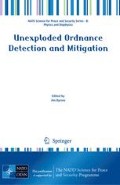Abstract
In this chapter, we outline the statistical procedures that can be employed for the detection of unexploded ordnance (UXO). Phenomenological modeling is first developed to relate the collected data to a sensor's feature parameters, which in turn allow for physics-based signal processing. Starting with the Bayesian framework, we introduce minimax and robust detection that do not require prior probabilities and distributional information on the measurement uncertainty, respectively. Nonparametric tests that perform well for broad classes of distributions are also presented. Finally, the generalized likelihood ratio test is described as a joint estimation-detection method which first estimates the feature parameters and then tests for the presence-absence of the UXO.
Access this chapter
Tax calculation will be finalised at checkout
Purchases are for personal use only
Preview
Unable to display preview. Download preview PDF.
References
L. Carin, H. Yu, Y. Dalichaouch, A. R. Perry, P. V. Czipott and C. E. Baum, “On the wideband EMI response of a rotationally symmetric permeable and conducting target,” IEEE Transac tions on Geoscience and Remote Sensing, Vol. 39, No. 6, pp. 1206–1213, June 2001.
C. -C. Chen and L. Peters, “Buried unexploded ordnance identification via complex natural resonances,” IEEE Transactions on Antennas and Propagation, Vol. 45, No. 11, pp. 1645–1654, November 1997.
A. Fijany, J. B. Collier and A. Citak, “Recent advances in unexploded ordnance (UXO) detec tion using airborne ground penetrating SAR,” Proceedings of the Aerospace Conference, 1999, pp. 429–441. Snowmass, Colorado, USA, March 1999.
J. I. Halman, K. A. Shubert and G. T. Ruck, “SAR processing of ground-penetrating data for buried UXO detection: results from a surface-based system,” IEEE Transactions on Antennas and Propagation, Vol. 46, No. 7, pp. 1023–1027, July 1998.
W. Hu, S. L. Tantum and L. M. Collins, “EMI-based classification of multiple closely spaced subsurface objects via independent component analysis,” IEEE Transactions on Geoscience and Remote Sensing, Vol. 42, No. 11, pp. 2544–2554, September 2004.
P. J. Huber, Robust Statistics, New York: Wiley, 1981.
D. Kazakos and P. Papantoni-Kazakos, Detection and Estimation, New York: Computer Sci ence Press, 1990.
C. V. Nelson, C. C. Cooperman, W. Schneider, D. S. Wenstrand and D. G. Smith, “Wide band width time-domain electromagnetic sensor for metal target classification,” IEEE Transactions on Geoscience and Remote Sensing, Vol. 39, No. 6, pp. 1129–1138, June 2001.
H. H. Nelson and J. R. MacDonald, “Multisensor towed array detection system for UXO detection,” IEEE Transactions on Geoscience and Remote Sensing, Vol. 39, No. 6, pp. 1139–1145, June 2001.
S. L. Tantum, Y. Yu and L. M. Collins, “Bayesian mitigation of sensor position errors to improve unexploded ordnance detection,” IEEE Geoscience and Remote Sensing Letters, Vol. 5, No. 1, pp. 103–107, January 2008.
R. van Waard, S. van der Baan and K. W. A. van Dongen, “Experimental data of a directional borehole radar system for UXO detection,” Proceedings of the Tenth International Conference on Ground Penetrating Radar, Delft, The Netherlands, June 2004, pp. 225–228.
F. Wilcoxon, “Individual comparisons by ranking methods,” Biometrics, Vol. 1, 1945, pp. 80–83.
D. Williams, C. Wang, X. Liao and L. Carin, “Classification of unexploded ordnance using incomplete multisensor multiresolution data,” IEEE Transactions on Geoscience and Remote Sensing, Vol. 45, No. 7, pp. 2364–2373, July 2007.
Q. Zhang, W. Al-Muaimy and Y. Huang, “Detection of deeply buried UXO using CPT mag netometers,” IEEE Transactions on Geoscience and Remote Sensing, Vol. 45, No. 2, pp. 410–417, February 2007.
Y. Zhang, L. Collins, H. Yu, C. E. Baum and L. Carin, “Sensing of unexploded ordnance with magnetometer and induction data: theory and signal processing,” IEEE Transactions on Geoscience and Remote Sensing, Vol. 41, No. 5, pp. 1005–1015, May 2003.
Author information
Authors and Affiliations
Editor information
Editors and Affiliations
Rights and permissions
Copyright information
© 2009 Springer Science + Business Media B.V.
About this paper
Cite this paper
Deliç, H. (2009). Overview of Statistical Tests for Unexploded Ordnance Detection. In: Byrnes, J. (eds) Unexploded Ordnance Detection and Mitigation. NATO Science for Peace and Security Series B: Physics and Biophysics. Springer, Dordrecht. https://doi.org/10.1007/978-1-4020-9253-4_5
Download citation
DOI: https://doi.org/10.1007/978-1-4020-9253-4_5
Publisher Name: Springer, Dordrecht
Print ISBN: 978-1-4020-9252-7
Online ISBN: 978-1-4020-9253-4
eBook Packages: Physics and AstronomyPhysics and Astronomy (R0)

